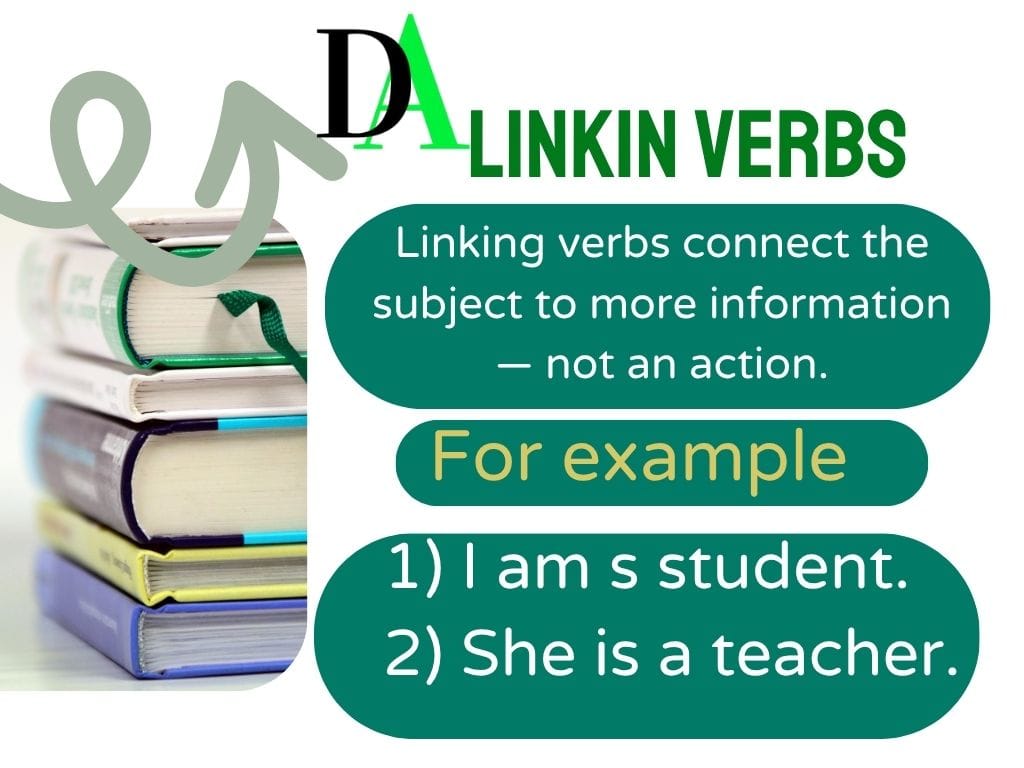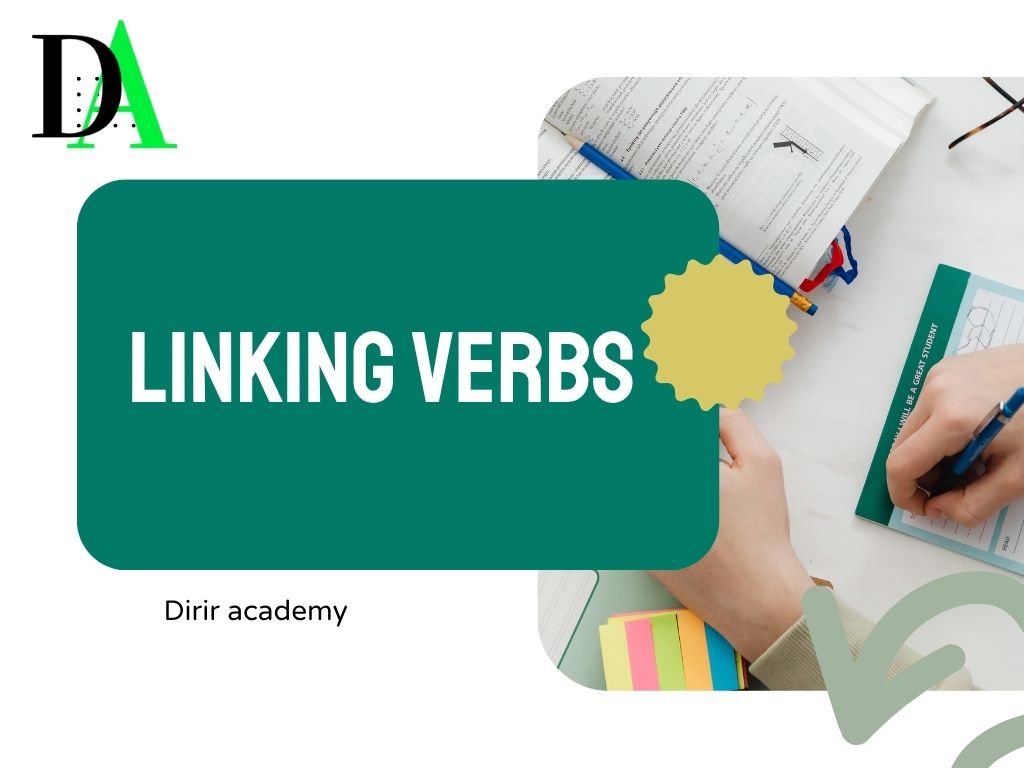Linking verbs are special verbs that don’t show action — instead, they tell us more about the subject of the sentence. While action verbs like “write” or “kill” describe what someone is doing, linking verbs like “is” or “are” simply connect the subject to examples. Look at these examples
• “Ali is student.”
• “teachers are good”
The word “is” tells us more about the subject (Ali) as well as the word “are” tells us more about the subject (teachers).
So you can see that these verbs help describe what someone or something is rather than what they do.
Grammatically, linking verbs are sometimes called copulas or copulae. They play a key role in English, especially since the verb “to be” — the most frequently used verb in English — is a linking verb.
In this article, we’ll discuss exactly what linking verbs are, how to use them correctly, and give you clear examples to guide your learning. But before we go further, let’s start with the basics: What is a linking verb?
What Are Linking Verbs?
Linking verbs are words that do not show action. Instead, they connect the subject of a sentence to more information about it. They link the subject to a noun, adjective, or phrase that describes it.
Examples:
• She is a teacher.
• They seem tired.
• The soup smells delicious.
In each case, the verbs “is, seem” and “smell” connect the subject with more information — but it doesn’t show action.

Why Are Linking Verbs Important?
linking verbs are important because they help us to give more details without making any action.
they are used to give more information about the subject so linking verbs will help us the following points
• Describe conditions or states (feelings, situations, identities)
• Improve sentence structure and fluency
• Make your writing and speaking clearer
❌ Incorrect: The dog cute.
✅ Correct: The dog is cute.
Without linking verbs, your sentence sounds broken or incomplete.
How to Identify Linking Verbs
Linking verbs can be tricky but easy to understand — they don’t show action like “learn” or “write.” Instead, they act like a bridge between the subject and something that describes it such us noun or adjective. So, how do you know if a verb is a linking verb? If you the following steps well you will identify easily
Here’s a simple, step-by-step guide to help you identify them in any sentence.
Step 1: Look at the Verb — Does It Show Action?
The first thing to ask yourself is: Is the verb doing something?
If it shows an action (something you can see, hear, or do), then it’s probably an action verb, not a linking verb.
Example:
• “She runs every morning.” → “Runs” shows action. ❌ Not a linking verb.
But if the verb doesn’t show action, and instead connects the subject to more information it is a linking verb.
Example:
She is a teacher
First ask your self is the subject “she” doing an action?
No, instead the “is” link the subject “she” to the noun “teacher” so it is linking verb.
Step 2: Try Replacing the Verb With “Is” or “Are”
Here’s the most helpful trick:
Replace the verb with “is” or “are.”
If the sentence still makes sense, the verb is probably a linking verb.
Example:
• “The soup smells delicious.”
→ Try: “The soup is delicious.” ✅️ Makes sense So the verb verb “Smells” is a Linking verb
• “He smells the soup.”
→ Try: “He is the soup.”❌ Doesn’t make sense so the verb “smells” is now an action verb
Step 3: Check What Comes After the Verb
Linking verbs are always followed by:
• A noun (She is a teacher.)
• An adjective (He feels tired.)
• A noun phrase (They became my best friends.)
They are not followed by other action verbs. If the verb is followed by another verb, it’s probably a helping verb, not a linking verb for example:
she wrote a letter
Ahmed reads the books every morning
The cat jumped over the wall.
Linking Verbs vs. Action Verbs
One verb can sometimes act as either a linking or action verb depending on the sentence.
| Sentence | verb type |
| she feels happy | Linking verb |
| she feels fabric | action verb |
as we described earlier “how to Identify the Linking verbs now to it is easier to understand the difference between linking verb and action verb only what you need is to read the little points.
Linking Verb:
• Describes a state or condition
• Doesn’t show an action
Example:- He is a good doctor
Action Verb:
• Shows physical or mental action.
Example:- He drove the car.
Linking Verbs vs. Helping Verbs
Most of the English learners confuse the difference between linking verbs and also helping verbs so let’s clarify:
Linking Verbs:
• Connect the subject to a description
• Stand alone
She is smart.
The word “is” which is the link connects the subject “she” to the word “smart” so, it is a linking verb.
Helping Verbs:
• Help the main verb express tense or mood
• Are used with another verb
She is eating lunch.
If the verb is followed by another verb, it’s likely a helping verb. If it’s followed by a noun or adjective, it’s likely a linking verb.
The 12 Most Common Linking Verbs
Here are the most frequently used linking verbs in English that most English learners use so read them well and use every in a sentence so you can understand more.
• is
• am
• are
• was
• were
• be
• being
• been
• seem
• become
• feel
• look
Tip: Master these first — they appear in everyday English.
Linking Verbs List (with Examples)
| Verb | Example |
| is | She is very smart. |
| am | I am ready. |
| are | They are tired. |
| was | He was angry yesterday. |
| were | We were late. |
| be | To be honest, I was nervous. |
| been | He has been sick all the week. |
| being | He is being rude. |
| seem | You seem confused. |
| become | The became a nurse. |
| feel | I feel excited. |
| appear | They appear unhappy |
| look | he looks tired. |
| sound | That idea sounds great. |
| smell | Dinner smells good. |
| taste | The cake tastes sweet. |
| remain | The room remained silent. |
| grow | She grew angry. |
| stay | Please stay calm |
| turn | The sky turned dark |
linking verb examples
Here are more examples to reinforce your understanding read and practice well.
• The baby is sleepy.
• My brother became a teacher.
• The cake smells amazing.
• That song sounds familiar.
• Her explanation was clear.
• I feel happy today.
• The room grew silent.
• They are amazing people.
• He seemed upset after the call.
• The pasta tastes too salty.
Linking Verbs Exercises
To check your understanding Try the following exercises do the exercise first by ignoring the answers then check that you answered correctly.
Exercise 1: Identify the Linking Verb
Find the linking verb in each sentence:
• The teacher is strict.
• He became a doctor.
• It tastes bitter.
• They seem happy.
• My phone was broken.
Answers: is, became, tastes, seem, wa
Exercise 2: Choose the Correct Verb
• She ___ (is/are) very smart.
• The children ___ (was/were) excited.
• The soup ___ (smell/smells) great.
• I ___ (feel/feels) tired today.
• That story ___ (sound/sounds) interesting.
Answers: is, were, smells, feel, sounds
Exercise 3: Fill in the Blank
• The sky ________ cloudy.
• I ________ nervous.
• My cat ________ playful today.
• She ________ like a teacher.
• The house ________ clean and tidy.
answers: is, am, seems, looks, looks
Real-Life Usage of Linking Verbs
We use linking verbs in our daily sentences they are so important in speaking we can’t speak without using linking verbs.
These are some common linking verbs you’ll hear in daily conversation:
• her phone is dead.
• That idea sounds interesting.
• The milk smells good.
• This film was boring.
• I feel great today!
Recommended source on English learning
Here are some books and to help you to understand English grammar and also practice well.
if read one of these books well and practice in your daily sentences or dialogue your English grammar will excellent
• English Grammar in Use by Raymond Murphy
• Practice Makes Perfect: English Grammar for ESL Learners
After buying these what you need is to read to give more effort so the good days will come and don’t forget to practice because practice makes you perfect.
Why Learning Linking Verbs Is important?
• You use them every day without even noticing.
• They help your English sound natural and clear.
• They’re essential for exams like IELTS, TOEFL, and school tests.
• They’re easy to learn — and once you get them, they stick with you for life.
I encourage you to practice these little words every day. Notice them in songs, movies, conversations — they’re everywhere. And the more you use them, the more your English will grow.
Conclusion:
Let me tell you something – linking verbs are powerful.
They may not “jump” “run” or “shout” like action verbs, but they do something just as crucial: they connect your ideas. They help you define how you feel, what a person is like, or what something is. That’s why sentences like “she is proud,” “he seems kind,” or “It looks good” make sense — all thanks to linking verbs.
Frequently Asked Questions (FAQ) on Linking Verbs
1. What is a linking verb in English?
A linking verb connects the subject of a sentence to more details about it. It doesn’t show action — it simply describes the subject’s state or identity. Look this example: She is happy. (“is” connects “she” with the description “happy”)
2. What are some common linking verbs?
The most common linking verbs you need:
• is
• am
• are
• was
• were
• be
• being
• been
• seem
• become
• appear
• feel
• look
• sound
• smell
• taste
• grow
• remain
• stay
• turn
Example sentences:
• Were are excited.
• The food smells bad.
• He became a doctor.
3. What’s the difference between linking verbs and action verbs?
• Action verbs show what someone does (e.g., kill, eat, read).
• Linking verbs show what someone is or feels (e.g., is, seems, feels).
Example:
• She feels the blanket. → Action (using her hand)
• She feels cold. → Linking (describes her condition)
4. Linking verbs vs. helping verbs
• Linking verbs describe the subject.
• Helping verbs come before another verb to support tense or meaning.
Example:
• She is a student. → Linking verb (describes her)
• He is studying English. → Helping verb (helps the main verb “studying”)
5. Can a verb be both linking and action?
Yes! Some verbs can act as either, depending on the sentence.
Example:
• She looks tired. → Linking
• She looks at the clock. → Action
6. Why should I learn linking verbs?
Because they’re everywhere in English! You use them when you talk about:
• How you feel?
I am happy.
• What things are? This seems easy.
• Who someone is? He is a teacher.
Read more
Watch this video for more details


Pingback: Common Noun: Definition with examples - Dirir Academy
Pingback: Helping Verbs— meaning and examples - Dirir Academy